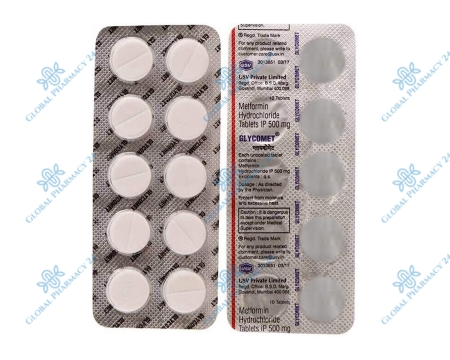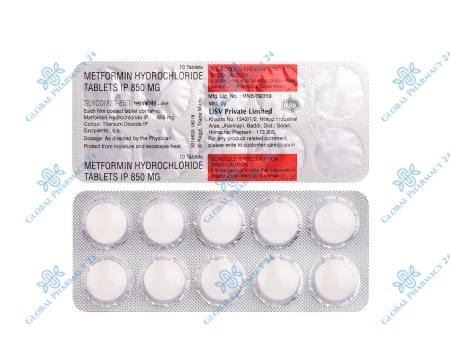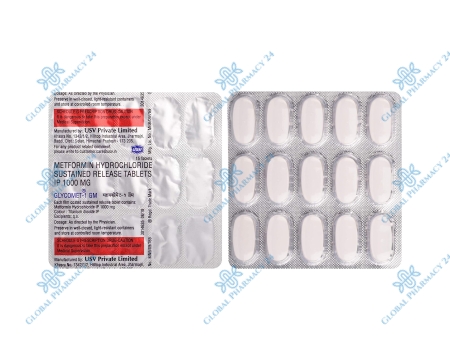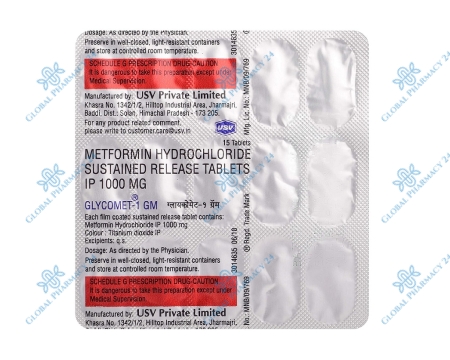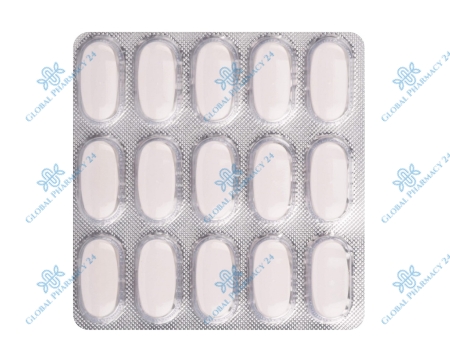| Characteristic | Detail |
|---|---|
| Active Ingredient | Metformin Hydrochloride |
| Dosage Forms | Tablet (500mg, 850mg, 1000mg) |
| Indications | Type 2 Diabetes, PCOS |
| Duration of Effect | 4-8 hours |
| Side Effects | Nausea, Vomiting, Diarrhea, Abdominal Pain |
Understanding Glycomet: The Lifesaver for Diabetic Patients
Glycomet, containing the active ingredient Metformin Hydrochloride, is a cornerstone in the management of type 2 diabetes. Its primary function is to improve blood glucose levels by enhancing insulin sensitivity and reducing glucose production in the liver. Unlike other diabetes medications, Glycomet does not increase the risk of hypoglycemia when used alone, making it a safer option for long-term management of diabetes.
As diabetes continues to be a major health concern worldwide, the role of medications like Glycomet in preventing complications cannot be overstated. Its effectiveness in controlling blood sugar levels, along with a well-balanced diet and regular exercise, helps patients lead a healthier and more active lifestyle. Furthermore, Glycomet's benefits extend beyond blood sugar regulation, offering potential advantages in weight management and cardiovascular health.
Unpacking the Ingredients: What Makes Glycomet Work?
The efficacy of Glycomet is primarily attributed to Metformin Hydrochloride, which suppresses hepatic gluconeogenesis (the production of glucose by the liver) and improves insulin sensitivity. This dual action helps in managing elevated blood glucose levels, which is crucial for diabetic patients. Moreover, Metformin has been studied for its effects on reducing insulin resistance, making it beneficial for patients with polycystic ovary syndrome (PCOS) as well.
How and Where to Purchase Glycomet
Glycomet is widely available in pharmacies across the United States, both in-store and online. Patients require a prescription to purchase Glycomet, ensuring its use is overseen by a healthcare professional. This ensures that the medication's dosage and administration are tailored to the individual's health needs, maximizing its benefits while minimizing potential risks.
Features of Glycomet: What Sets it Apart
Glycomet's distinction lies in its broad applicability and safety profile. It is often the first-line treatment for type 2 diabetes due to its minimal risk of causing hypoglycemia compared to other antidiabetic drugs. Additionally, Glycomet has a positive effect on weight control, which is particularly beneficial for diabetic patients struggling with obesity. This aspect sets Glycomet apart from other diabetes medications that may contribute to weight gain.
Another notable feature of Glycomet is its cardiovascular benefits. Studies have indicated that Metformin can reduce the risk of cardiovascular events, making it a preferable choice for patients with type 2 diabetes who are at increased risk of heart disease. Its well-established safety profile, coupled with these benefits, underscores its importance in diabetes management.
High-Efficiency at a Fair Price: Glycomet 1000mg Tablets
The 1000mg formulation of Glycomet offers a convenient dosing schedule that can improve patient compliance, an important factor in the long-term management of diabetes. Additionally, its cost-effectiveness makes it accessible to a wide range of patients, ensuring that more individuals can benefit from its therapeutic effects without financial burden.
Beyond Diabetes: Glycomet as a Weight Loss Ally
While Glycomet is primarily used to manage diabetes, its role in weight management has garnered attention. By improving insulin sensitivity and reducing insulin levels, Metformin can help with weight loss efforts, especially in individuals with insulin resistance. This makes Glycomet a valuable tool not only for diabetic patients but also for those looking to manage their weight more effectively.
The Power of Glycomet: Medical Effects
Glycomet's mechanism of action is multifaceted, addressing the core issues in type 2 diabetes management. It reduces hepatic glucose production, decreases intestinal absorption of glucose, and improves glucose uptake by skeletal muscles. These actions collectively help in lowering fasting and postprandial blood glucose levels, a crucial aspect of diabetes care.
Moreover, Glycomet's impact on metabolic markers, such as improving lipid profiles and reducing inflammatory markers, contributes to its wide-ranging benefits. This not only aids in glycemic control but also addresses the metabolic syndrome often associated with type 2 diabetes, highlighting its comprehensive approach to treatment.
Suppressing Gluconeogenesis and Promoting Glucose Utilization
Glycomet's ability to suppress gluconeogenesis and promote glucose utilization in peripheral tissues is fundamental to its effectiveness. This reduces the need for exogenous insulin administration and supports the body's natural metabolic processes, offering a sustainable approach to managing diabetes.
Using Glycomet: Dosage and Administration
The starting dose of Glycomet for adults is typically 500mg taken twice a day or 850mg once daily, with gradual adjustments based on the patient's response and tolerance. It is important to take Glycomet with meals to reduce gastrointestinal side effects. The maximum recommended daily dose is 2550mg. Patients are advised to regularly monitor their blood glucose levels to ensure optimal control.
Consistency in taking Glycomet as prescribed is key to achieving the desired therapeutic effects. Missed doses should be taken as soon as remembered, but if it is almost time for the next dose, the missed dose should be skipped to avoid doubling up. Always consult a healthcare provider before making any changes to the medication regimen.
Interactions of Glycomet with Other Drugs
Glycomet can interact with other medications, which may alter its effectiveness or increase the risk of adverse effects. Notably, diuretics, steroids, and other diabetes medications can affect blood glucose levels and may require dosage adjustments. Patients should inform their healthcare provider of all medications they are taking, including over-the-counter drugs and herbal supplements, to avoid potential interactions.
Additionally, contrast media used in certain radiological studies can increase the risk of lactic acidosis in patients taking Metformin. It is usually advised to temporarily discontinue Glycomet before undergoing such procedures and to monitor kidney function as a precaution.
Possible Side Effects of Glycomet
Common side effects of Glycomet include gastrointestinal symptoms such as nausea, vomiting, diarrhea, and abdominal pain. These are often transient and can be minimized by taking the medication with food. Long-term use of Metformin has been associated with vitamin B12 deficiency in some patients, necessitating periodic monitoring of vitamin B12 levels.
Rarely, more serious side effects like lactic acidosis may occur, characterized by muscle pain, breathing difficulties, and dizziness. Immediate medical attention is required if these symptoms develop. Patient education on recognizing the signs of hypoglycemia and lactic acidosis is crucial for safe use of Glycomet.
Other Therapeutic Options for Diabetes
In addition to Glycomet, there are various other therapeutic options for managing diabetes, including newer classes of medications like SGLT2 inhibitors and GLP-1 receptor agonists. These drugs offer different mechanisms of action, such as increasing urinary glucose excretion or enhancing insulin secretion in response to meals, providing additional benefits such as weight loss and cardiovascular protection.
Lifestyle modifications, including diet and exercise, remain foundational in diabetes management. For some patients, insulin therapy may be necessary to achieve optimal blood glucose control. A comprehensive treatment plan tailored to the individual's needs and medical condition is essential for effective diabetes management.
Glycomet and Lifestyle Medications: An Overview
Glycomet's role in managing diabetes extends beyond medication alone. It emphasizes the importance of a holistic approach that includes lifestyle modifications. Incorporating a healthy diet, regular physical activity, and weight management strategies enhances the effectiveness of Glycomet, leading to improved glycemic control and overall health.
Furthermore, Glycomet's positive effects on weight and metabolic health can motivate patients to maintain a healthier lifestyle. Education on the proper use of Glycomet, alongside lifestyle interventions, can empower patients to take an active role in managing their diabetes, resulting in better long-term outcomes.
FAQs Glycomet
What is Glycomet?
Glycomet is a brand name for the medication metformin, which is commonly used to treat type 2 diabetes.
How does Glycomet work?
Glycomet works by decreasing glucose production in the liver and improving insulin sensitivity in muscle and fat tissues, thereby lowering blood sugar levels.
What are the common side effects of Glycomet?
Common side effects of Glycomet include gastrointestinal discomfort such as nausea, vomiting, diarrhea, and abdominal pain. It may also cause a metallic taste in the mouth.
Can Glycomet be used to treat type 1 diabetes?
No, Glycomet (metformin) is not indicated for the treatment of type 1 diabetes. It is only approved for use in type 2 diabetes.
How should Glycomet be taken?
Glycomet should be taken exactly as prescribed by a healthcare professional. It is usually taken with meals to reduce gastrointestinal side effects. Dosage may vary depending on individual medical conditions.
Is Glycomet safe during pregnancy?
It's important to consult with a healthcare provider before taking Glycomet during pregnancy. While some studies suggest it may be safe for pregnant women with diabetes, others recommend discontinuing it during pregnancy due to potential risks.




